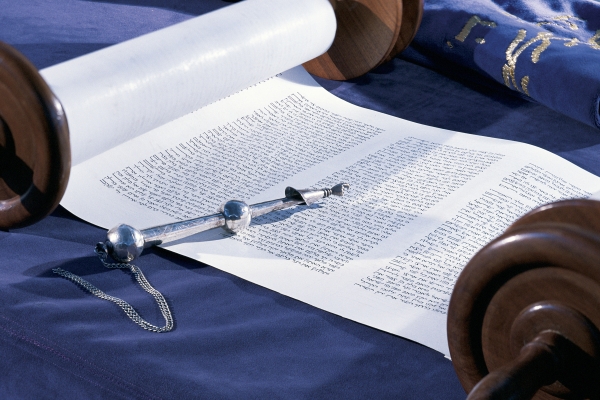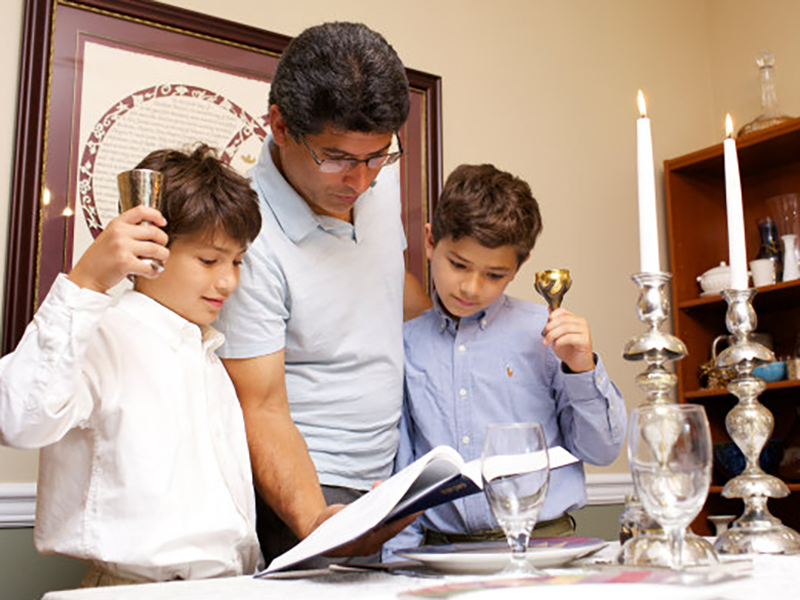
There is a section of Parashat Va-eira that might sound familiar to those who have experienced a Passover seder:
Say, therefore, to the Israelite people: I am the Eternal. I will free you from the labors of the Egyptians and deliver you from their bondage. I will redeem you with an outstretched arm and through extraordinary chastisements. And I will take you to be My people, and I will be your God. And you shall know that I, the Eternal, am your God who freed you from the labors of the Egyptians. I will bring you into the land which I swore to give to Abraham, Isaac, and Jacob, and I will give it to you for a possession, I the Eternal. (Ex. 6:6-8)
At the seder, we do not read these three verses together, all at one time. Instead, each of the first four promises is mentioned with one of the four cups of wine we raise, bless, and drink throughout the meal. With cup number one, we have v’hotzeiti — I will free you; with cup number two, v’hitzalti — I will deliver you; with cup number three, v’ga-alti — I will redeem you; and with cup number four, v’lakachti — I will take you. The Passover seder commemorates each of these completed stages of our redemption as we literally drink a toast to each one.
As for the fifth assertion, to bring us into the Land that was promised to our ancestors, here the Sages disagreed. Some say yes, this promise has been fulfilled: The Israelites’ 40 years of wandering in the wilderness came to an end. They settled in the Promised Land, and so we should drink a fifth cup. Yet other Sages said no, this promise has not yet been fulfilled: While the ancient Israelites once flourished in the Promised Land, devastating exile followed. Thus, they say, we should not drink a fifth cup. What to do? Their solution: We do have a fifth cup, but we don’t drink it. We set the fifth cup aside for Elijah, for we are taught that when he comes, heralding the arrival of the Messiah (or the Messianic Age), all questions will be answered. It’s hard to believe this would be the most pressing question, but there you have it.
At the same time, Sages from the Talmud to Rashi agree about these verses and others in Torah that our sacred text is not redundant. Therefore, each of these five promises must be different; a unique stage of our redemption, a piece of the whole. Liberation, we learn, is a process. It only begins with the granting of freedom or emancipation. But “it is not enough to remove the burden of slavery; they [those who have been enslaved] must also have the proper circumstances that will permit them to flourish as God’s people” (Etz Hayim Torah and Commentary [Philadelphia: JPS, 2001], p. 352).
The Open Door: A Passover Haggadah identifies the first stage as simple awareness: “When we are numb to the pain of bondage, we do not know that we are enslaved. When we acknowledge and address that pain, we become God’s partners in liberation.” (Sue Levi Elwell, ed. [NY: CCAR Press, 2002], p. 16). The fourth stage is covenant — an eternal, essential commitment on behalf of all parties that liberation will be full, inclusive, and lasting. This too has yet to be fulfilled.
In North America today, the United States still struggles with the vestiges of slavery, and it is worth asking where it is in the process of liberation. The country’s Emancipation Proclamation took effect on January 1, 1863, freeing enslaved individuals from a certain kind of grueling, driven labor. Yet that was only “stage one.” It would be decades upon decades before additional “promises” would materialize, in the form of legislation to safeguard the right of African Americans to vote, integrate public schools, and protect against discrimination in employment. However, far from propelling liberation forward, each of those promises has proven susceptible to, at least partial, revocation. Abiding, systemic racial disparities in virtually every aspect of American society — from education to criminal justice to home ownership to health care — suggest we are far from the covenantal commitments that would accompany a higher level of liberation.
In January of 1963, exactly one century after the proclamation, Rabbi Abraham Joshua Heschel addressed the attendees at a Chicago Conference on Religion and Race:
At the first conference on religion and race, the main participants were Pharaoh and Moses. Moses’ words were: “Thus says the Lord, the God of Israel, let My people go that they may that they may celebrate a feast to Me.” ... The outcome of that summit meeting has not come to an end. Pharaoh is not ready to capitulate. The exodus began, but is far from having been completed. In fact, it was easier for the children of Israel to cross the Red Sea than for a Negro to cross certain university campuses. (Heschel, “Religion and Race,” January 14, 1963)
We are not commanded merely to remember and celebrate the Exodus, and we cannot wait for Elijah. It is our responsibility to help advance liberation toward completion.
Rabbi Stephanie M. Alexander is the senior rabbi at Kahal Kadosh Beth Elohim in Charleston, SC. She is a past-president and founding member of the Charleston Area Justice Ministry, a faith-based social justice organization of 29 diverse congregations.
 This week, we have two prophets on our minds: on Monday, we celebrated the legacy of Rev. Dr. Martin Luther King, Jr. and on Shabbat, we pick up with the second episode in the story of Moses in Parashat Va-eira. As we consider the legacy of these two giants of justice, a notable difference between them is their mode of freedom fighting. While Dr. King was awarded the Nobel Peace Prize for leading the nonviolent resistance that defined the Civil Rights Movement, Moses kissed his chances for a ticket to Oslo goodbye the moment he commanded Aaron to hold his staff over the Nile and it turned into a river of blood.
This week, we have two prophets on our minds: on Monday, we celebrated the legacy of Rev. Dr. Martin Luther King, Jr. and on Shabbat, we pick up with the second episode in the story of Moses in Parashat Va-eira. As we consider the legacy of these two giants of justice, a notable difference between them is their mode of freedom fighting. While Dr. King was awarded the Nobel Peace Prize for leading the nonviolent resistance that defined the Civil Rights Movement, Moses kissed his chances for a ticket to Oslo goodbye the moment he commanded Aaron to hold his staff over the Nile and it turned into a river of blood.
In her teaching, Rabbi Alexander explains how the Torah outlines the stages of the redemptive process and challenges us to play our part in its unfolding. In this davar acher, I hope to reconcile the tale of Moses and the Ten Plagues with our contemporary nonviolent sensibilities as inspired by Dr. King.
At the beginning of Va-eira, Moses speaks to the enslaved Israelites about God’s promise, about the Holy Land, and about their destiny to inherit it. But after 400 years of slavery, the Israelites respond with justifiable skepticism. They roll their eyes at Moses, brush him off, and return to life as usual. From his own prophetic experience, Dr. King described despondency like this: “[Some people] discover the difficulties of the wilderness moving into the promised land, and they would rather go back to the despots of Egypt because it’s difficult to get in the promised land. And so they resign themselves to the fate of oppression” (A Knock at Midnight, [NY: Warner Books, 1998]). Such were children of Israel on the eve of the Ten Plagues: they had given up on God and on themselves. They had surrendered to slavery.
And then there was a deluge. We usually think of the Ten Plagues as history’s most horrific pressure campaign. But another essential purpose of the plagues was to refresh the faith and hope of the Israelites. Enchained in Egypt, trapped in the narrow place, why would the Israelites believe that the God of Abraham had suddenly remembered them? How could they believe that they could challenge the status quo? And so, though the plagues were terrible, we must remember that they nonetheless represented wonders, signs of our God’s ultimate power. And in witnessing the fiery fate of the Egyptians, the Children of Israel found their faith.
But their renewed faith was not in God — it was in themselves.
The suffering brought by the plagues, even though it was upon our enemies, proved too much for our ancestors. The plagues were our people’s collective wake up call. They opened our eyes to the static, oppressive Egypt of violence that is this world that we inhabit. And they taught us, in the words of Dr. King, “That old law about ‘an eye for an eye’ leaves everybody blind.”
Our tradition teaches us that we should love our enemies. In the Talmud, we read that God rebukes the angels for singing when the parted waters of the Red Sea come crashing down upon the Egyptians: "The work of My hands sinks into the sea, and you would sing before Me?" (Sanhedrin 39b) And we read, "If a man finds both a friend and an enemy requiring assistance, he should assist his enemy first in order to subdue his evil inclination" (Bava M’tzia 32b).
Dr. King agrees: “…love is not this sentimental something that we talk about... Love is creative, understanding goodwill for all men. It is the refusal to defeat any individual. When you rise to the level of love…you seek only to defeat evil systems. Individuals who happen to be caught up in that system, you love…” (ibid., A Knock at Midnight)
For this reason, when we list the Ten Plagues at our Passover seders, we spill wine from our cups. We do not rejoice in the suffering of God’s children. In fact, we deliberately diminish our joy.
Though slavery does not directly touch many of us today, slavery does indeed still exist in our world. Furthermore, we live on a planet sweltering with heat of injustice and oppression. Hunger, poverty, cancer, climate change, violence, terrorism — these are the godless plagues of the modern world. And the message of the Ten Plagues of old is that we as Jews must act when we see these horrors, even if they befall our enemies. We must do this because, to borrow the words our great American prophet, “Injustice anywhere is a threat to justice everywhere.”
Rabbi Dan Ross is a rabbi at Central Synagogue in New York City.
Va-eira, Exodus 6:2−9:35
The Torah: A Modern Commentary, pp. 420−448; Revised Edition, pp. 379–400
The Torah: A Women’s Commentary, pp. 331–354
Haftarah, Ezekiel 28:25–29:21
The Torah: A Modern Commentary, pp. 696−99; Revised Edition, pp. 401−04
Explore Jewish Life and Get Inspired
Subscribe for Emails

